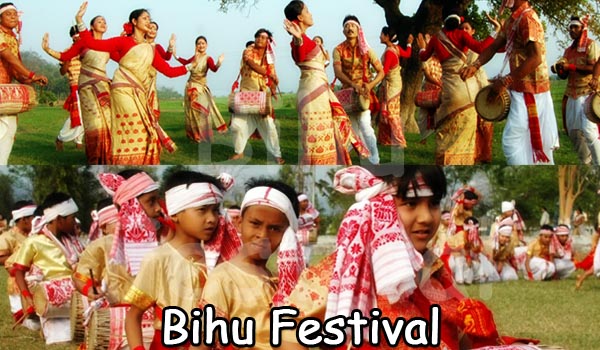‘Bihu’ is most important festival of Assamese people observed by all classes and castes. Festival has been adjusted at different ages; taking into consideration changed situation of particular age. ‘Bihu’ is mainly culture of masses, secular in concept and intimately connected with agriculture.
‘Bahag Bihu’:
Most popular is ‘Bohag Bihu’ or ‘Rongali Bihu’ celebrated on 15th April of every year. This is also the Assamese New Year when spring arrives. It is time for merriment and feasting that continues for several days. Farmers prepare fields for cultivation of paddy so there is feeling of joy all around. Women make pithas and larus that are traditional food made of rice and coconut. This gives the real essence of the season.
First day of ‘Bihu’ is ‘Garu Bihu’ or Cow ‘Bihu’, when cows are washed and worshipped. This is followed by ‘Manuh’ [human] ‘Bihu’. The folk songs associated with the ‘Bahaag Bihu’ are known as ‘Bihugeets’ or ‘Bihu’ songs. In villages groups of young men and girls in beautiful traditional Assamese attires wander around. They sing ‘Bihugeets’ or ’Bihu’ songs of love and romance.
‘Magh’ or ‘Bhogali Bihu’:
‘Magh Bihu’ or ‘Bhogali Bihu’ is celebrated around mid-January. This is at the end of harvesting season. Hence, there is lots of feasting during this period. Granaries are full so people unite. They make a small hut type structures called ‘Mejis’. During the night, food for the community feast is prepared in many places. ‘Meji’ is made of wooden logs placed in pairs, tier above tier reaching considerable height. Thus, ‘Meji’ resembles a lofty temple.
Entire night is spent around bonfire; people sing ‘bihu’ songs, beat drums and play games. Next morning, people gather around the ‘Mejis’ and set it on fire. While it is burning, they throw ‘pithas’ [rice cakes] and betal nuts. People offer prayers to Fire God to celebrate the end of harvesting year.
‘Kaati’ or ‘Kongaali Bihu’:
‘Kaati Bihu’ or ‘Kongaali Bihu’ is celebrated in mid-October. This is very different because of less merriment; the atmosphere is constraint and solemn. This festival is held on last day of Aswin and it coincides with autumnal equinox. Festival is called ‘Kangali’
(poor). This is because there is not much to eat during this time of year. During this Bihu, the main function is worshiping of the sacred ‘tulsi’ (basil) plant. Near the base of these plants, earthen oil lamps are placed.
During this time, paddies still grow in fields and farmer’s granaries are almost empty. Hence, this festival is referred to as empty bihu. People fast during the day. In the evening, they offer prayers to ‘Tulsi’ plant and paddy fields. People light ‘diyas’ (earthen lamps) hoping that there is a good harvest. Also the light wards off any evil eyes. There is also exchange of sweets and greetings at this time.
